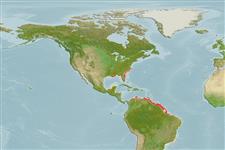Environment: milieu / climate zone / depth range / distribution range
Ökologie
seewasser; süßwasser; brackwasser demersal. Tropical
South America: Caribbean and Atlantic draining rivers and estuaries from Colombia to Brazil.
Length at first maturity / Size / Gewicht / Alter
Maturity: Lm 50.8, range 45 - 56.5 cm
Max length : 94.2 cm TL Männchen/unbestimmt; (Ref. 10652); 62.5 cm TL (female); common length : 30.0 cm TL Männchen/unbestimmt; (Ref. 3265); max. veröff. Gewicht: 1.5 kg (Ref. 5217)
Adults occur in turbid estuaries, mangrove-lined lagoons and lower parts of rivers being very tolerant to changes in salinity. Found on shallow soft bottoms (Ref. 5217). Feed on a large variety of bottom-living and pelagic organisms including those found among the roots of mangroves. Reproduction occurs between September and December. A female lays 20-30 eggs, with a diameter of 10-12 mm. Males incubate the eggs in their mouth (Ref. 35381).
Females reach maturity at a younger age than males and grow faster. The male incubates 28-40 eggs in the mouth and 200-400 eggs that are fixed in a glutinous mass on its head. Incubation takes 10-12 days. After 50-60 days fully functional young (6-6.5 cm TL) are released.
Chacon, J.O., M.I.M. Alves and M.S.C. de Mesquita, 1994. Alguns aspectos da reprodução do bagre branco, Selenapsis herzbergii (Bloch 1794), Pisces: Ostariophysi, Siluriformes, Ariidae. Bol. Tec. DNOCS. 47/52(1/2):43-78. (Ref. 10652)
IUCN Rote Liste Status (Ref. 130435)
Bedrohung für Menschen
Traumatogenic (Ref. 58010)
Nutzung durch Menschen
Fischereien: weniger kommerziell
Mehr Information
ReferenzenAquakulturAquakultur ProfilZuchtlinienGenetikElectrophoresesVererbbarkeitKrankheitenVerarbeitungNutrientsMass conversion
PartnerBilderStamps, Coins Misc.LauteCiguateraGeschwindigkeitSchwimmstilKiemenoberflächeOtolithsGehirngrößeSehfähigkeit
Tools
Zusatzinformationen
Download XML
Internet Quellen
Estimates based on models
Preferred temperature (Ref.
123201): 23.4 - 27.9, mean 25.6 °C (based on 428 cells).
Phylogenetic diversity index (Ref.
82804): PD
50 = 0.5039 [Uniqueness, from 0.5 = low to 2.0 = high].
Bayesian length-weight: a=0.00575 (0.00474 - 0.00698), b=3.13 (3.07 - 3.19), in cm total length, based on LWR estimates for this species (Ref.
93245).
Trophic level (Ref.
69278): 3.3 ±0.39 se; based on food items.
Generation time: 3.8 ( na - na) years. Estimated as median ln(3)/K based on 1
growth studies.
Widerstandsfähigkeit (Ref.
120179): mittel, Verdopplung der Population dauert 1,4 - 4,4 Jahre. (tm=2-3; Fec=200).
Fishing Vulnerability (Ref.
59153): Moderate vulnerability (39 of 100).
Nutrients (Ref.
124155): Calcium = 93.2 [51.2, 182.5] mg/100g; Iron = 0.957 [0.621, 1.530] mg/100g; Protein = 16.8 [15.2, 18.5] %; Omega3 = 0.155 [0.087, 0.265] g/100g; Selenium = 75.6 [42.4, 141.5] μg/100g; VitaminA = 11 [5, 23] μg/100g; Zinc = 1.14 [0.79, 1.68] mg/100g (wet weight); based on
nutrient studies.
